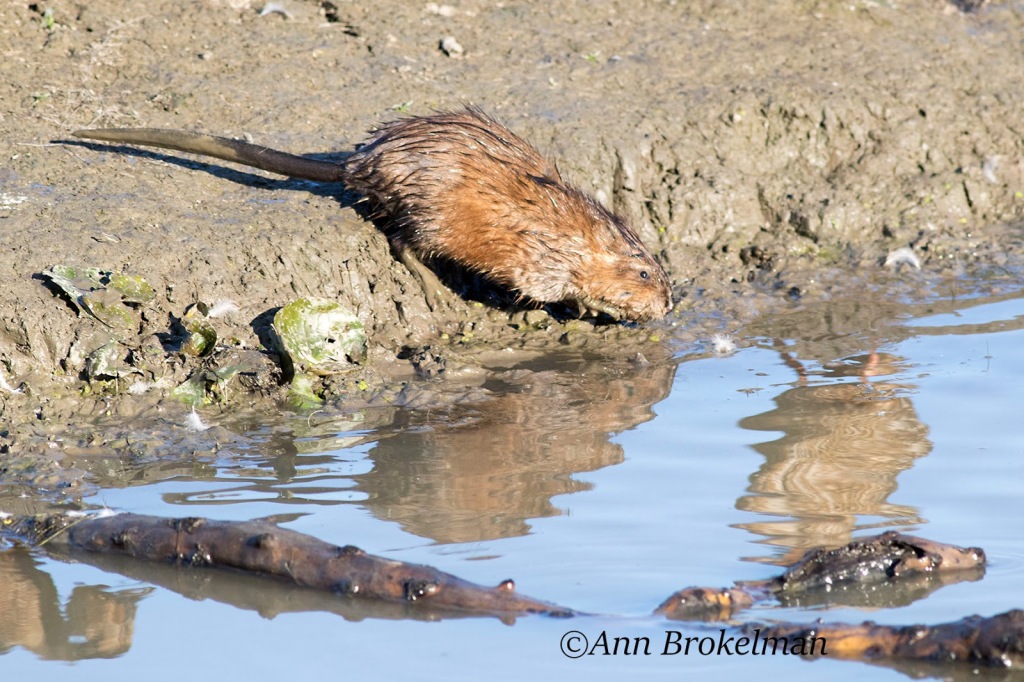
Photo by: Ann Brokelman
Species: Muskrat
Scientific name: Odanta zibethicus
Status: common
Description: The muskrat is a large rodent found in wetlands and waterways. They are quite rotund, with thick dark brown to grey-brown fur on their bodies, a skinny tail and lightly furred feet. Many people mistake them for baby beavers, but they are NOT beavers. This aquatic rodent averages 1kg in weight and is approximately 50cm from nose to end of tail.
Habitat: Muskrats need to live close to water. They are commonly seen in wetlands and waterways where they can quickly escape to their dens they build out of cattails or bulrushes. In these aquatic habitats, the water must be deep enough to not fully freeze to the bottom during the winter months, but shallow enough for aquatic vegetation to grow. During the winter months, muskrats will chew through the ice and create “push-ups”, which is then covered in mud and plant material, creating the appearance of a miniature lodge. This is where they can leave to come above the ice and look for food, or somewhere to rest while gathering food. Winter is a period of inactivity for muskrats and they will spend most of their time in their lodges.
Breeding: Springtime is when mating activities begin, usually starting in March and running until late summer (August). These rodents do not form lifelong pairs, and are quite promiscuous, with males competing fiercely for females. Females can have up to 10 young, and up to 3 litters during mating season. Their gestation period is quick, and females will birth their litters less than one month after mating. Young muskrats grow quickly, their eyes will be open after 2 weeks and they will start exploring away from the den as early as 3 weeks of age. At this time, they are also slowly weaned from mothers’ milk onto other foods, and are independent at 6 weeks.
Diet: Muskrats are a somewhat picky eater, preferring cattails over any other food source. However, they will also eat bulrushes, horsetails, and pondweeds. When plant material is limited, muskrats will adjust to a more carnivorous diet, eating fish, frogs and clams.
Threats to species: Muskrats are a prey species to a number of predators including foxes, mink and other predators, especially as they age (3 years old is considered quite old). During dispersal, the young of the previous year must move away from their birth ponds to find their own territory, this makes them very vulnerable as they must travel over land and are commonly killed by cars. Muskrats are also commonly hunted for their fur.
Threat to humans: Muskrats are quite vicious fighters when provoked and will stand their ground. But they cause no threat to humans.
Fun facts:
Muskrats, similar to beavers, can stay underwater for 15+ minutes.
Muskrats are able to hold their breath for so long by reducing their heart rate and relaxing their muscles while submerged. This reduces their oxygen consumption.
Muskrats are capable of chewing underwater by closing their lips behind their incisors. This stops water and mud from entering their mouth.
Muskrat dens will often be used by geese as nesting platforms in wetlands.
Muskrat numbers fluctuate every 7-10 years. With heavy die offs and low populations taking 1-2 years to recover. The reason behind this isn’t entirely clear, but it is believed to be due to the deterioration of healthy individuals and reproductive failure.
Sources:
Hinterland Who’s Who- https://www.hww.ca/en/wildlife/mammals/muskrat.html#sid2
Eder, Tamara, and Kennedy, Gregory. 2011. Mammals of Canada. Lorne Pine Publishing. Edmonton, Alberta.
